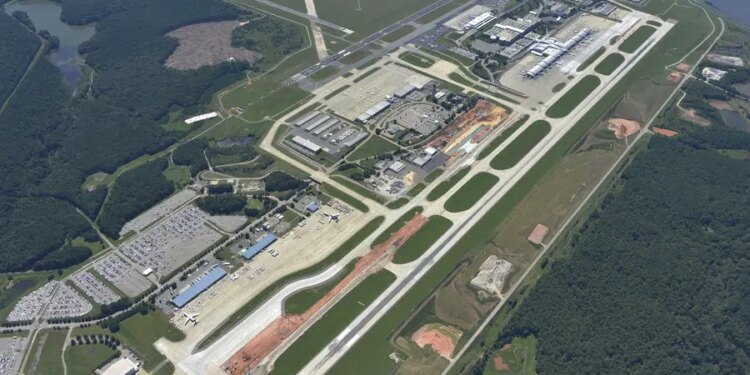Raleigh-Durham International Airport (RDU) is celebrating a significant milestone as it moves closer to its planned $500 million runway expansion project. The Federal Aviation Administration (FAA) recently granted authorization for the project, signaling an important step towards the airport’s growth plans.
Michael Landguth, CEO of the Raleigh-Durham Airport Authority, emphasized the importance of obtaining FAA authorization. It provides airlines with the assurance that a replacement runway is on the horizon, ensuring uninterrupted flight services despite the existing runway reaching its lifespan expiration.
Raleigh-Durham International Airport runway expansion project timeline
The approved runway expansion project aims to construct a new runway spanning over 10,600 feet, with completion projected for 2028. This upgrade is crucial for RDU since the current primary runway, built in the 1980s and measuring 10,000 feet, needs replacement. The new runway will be strategically placed more than 500 feet west of the current runway, allowing the existing one to remain operational during construction and minimizing disruptions to air travel.
Bill Sandifer, Chief Development Officer at Raleigh-Durham International Airport (RDU), outlined the next steps in the expansion project. The airport plans to submit applications for state and local permits in the next 30 to 60 days, signaling continued progress. Construction activities are scheduled to begin next year, starting with preliminary site work, including the demolition of three buildings near Lumley Road.
In addition to the runway expansion project, the Airport Authority has approved plans to advance Terminal 1’s planning and concept designs for future expansion. This includes improvements to various airport amenities such as roadways, parking facilities, ticketing areas, gate sections, concessions, and pre- and post-security zones. These developments highlight RDU’s commitment to enhancing the travel experience for its passengers and solidify its position as a dynamic hub for both domestic and international travel.
Frequently Asked Questions (FAQ)
1. What is the purpose of Raleigh-Durham International Airport’s runway expansion project?
The runway expansion project aims to construct a new runway to replace the existing one, which is reaching the end of its lifespan. This upgrade is crucial for maintaining uninterrupted flight services and accommodating the airport’s ambitious growth plans.
2. When is the projected completion date for the runway expansion project?
The anticipated completion date for the runway expansion project is set for 2028.
3. How will the construction of the new runway impact current air travel?
The new runway will be strategically placed more than 500 feet west of the current runway, allowing the existing one to remain operational during construction. This will minimize disruptions to air travel.
4. What other enhancements are planned at Raleigh-Durham International Airport?
In addition to the runway expansion project, the Airport Authority has approved plans to advance Terminal 1’s planning and concept designs for future expansion. This includes improvements to various airport amenities, such as roadways, parking facilities, and gate sections, among others.
5. How will these developments benefit passengers?
These developments aim to enhance the travel experience for passengers by improving airport amenities and infrastructure. This includes upgraded roadways, parking facilities, ticketing areas, concessions, and pre- and post-security zones.
Closing Statements
The runway expansion project at Raleigh-Durham International Airport is an important milestone in the airport’s growth plans. With FAA authorization granted, the construction of a new runway will ensure uninterrupted flight services and support the airport’s commitment to an improved travel experience for its passengers. The strategic placement of the new runway will minimize disruptions to air travel during the construction phase. These developments, along with plans for Terminal 1’s expansion, position RDU as a dynamic hub for both domestic and international travel.



